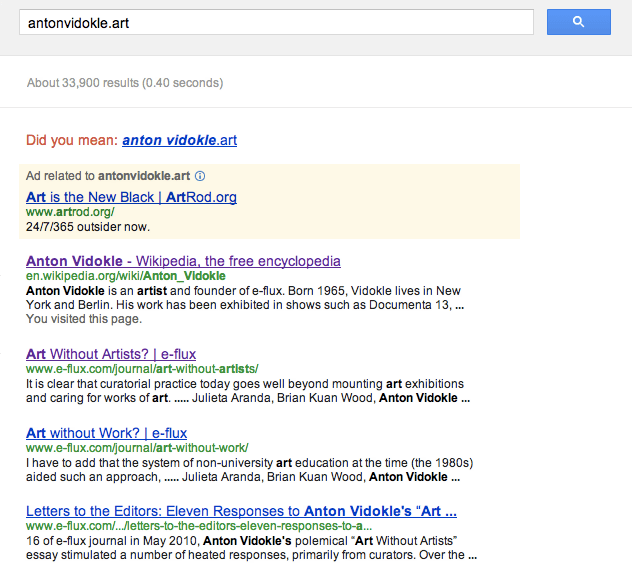With ownership comes responsibility. With responsibility comes agency. With agency comes accountability. The public recently found out that a) .art TLD will be available, b) various ventures have applied to own the control of the top level domain. After a flux of information and—admittedly—emotions, the virtual dust has settled and one can’t help but wonder, what are the potentialities liberated through .art? m-est asked.
We’ll be updating this post as we receive more responses.
***
—Anonymous, artist, August 2012
***
In my opinion, the categorical division of internet domains may not have as far-reaching consequences as believed. This division will only be an optional one; it will not be enforced by any local or international entity. As a result, “specialized” domain names will only have cosmetic utility.
We have seen one such division already; the “.xxx” domain name has been established for porn sites since November 2011. Such an addition has not changed the domain names of the most popular pornography pages, nor has it given any advantages to those using it. The internet is pretty much a bottom-up arena of interaction and content creation, organizations attempting top-down changes will see their plans bypassed, ignored, and changed. To go back to the .xxx example, the domain name is now particularly popular among extreme sports sites – hardly a purpose envisioned by the ICANN.
Moving from the world of porn to the art world, I predict the impact to be similarly mediocre. Surely, there will be a lot of debates on ownership, control and the commodification of the arts, as well as the usual issues on what constitutes art on the internet. Perhaps some people will “protest” this by establishing critical projects and/or platforms on a non .art domain. This change, however, will not be noticed by the majority of the galleries, artists, and art platforms online, nor will it change the way art is produced, found, discussed, and interacted with on the digital realm. Perhaps some excited institutions may purchase .art domains in order to lend themselves a more artistic air.
It is very strange that e-flux has not realized just how superficial this change will be. The .art domain will not be “…an important resource for art professionals, educators, institutions, and especially the public at large…” anymore than a 1800-ART phone line would be.
—Mehmet Kösemen, artist and advertiser, August 2012
***

—Özge Ersoy, curator/writer, August 2012
***
.art is not available yet, and there are ten companies who have applied to set up its structure (the application itself costs $186,000).[i] Two of applicants, e-flux and dadotart.com, are strengthened by ‘community endorsement’, and the rest are typical domain sellers.
The endorsements for e-flux, coming from a wide range of institutions including galleries, art fairs, and bigger art institutions, and written endorsements state “Under e-flux custodianship, the .ART gTLD will become a valuable and encyclopedic resource for anyone interested in art”.
Note custodianship. Derived from the Latin custos guard; sentry, watch; jailer, warden; poll watcher.
The other community application from dadotart.com (You might have heard of deviantart website) has the following endorsement from Deviantart community: “The primary mission and purpose of the .ART gTLD is to provide a trusted, hierarchical, and intuitive online marketplace for Internet users seeking to share works of art or to exchange ideas about art and to access resources for the arts and about the arts. Under the Dadotart stewardship, the .ART gTLD will be reserved for the use of members of the artistic community and will give them a much needed identity of their own within the culture that is the Internet.”
Note Stewardship. Middle English, from Old English stīweard,from stī, stig hall, sty + weard ward.
It seems that the community thinks .art doesn’t have to be just managed but protected. I would rather prefer non-art professionals to manage the .art domain as I don’t agree with the view that sees art as something sublime. The magic doesn’t come from its physical presence or (lack of it) neither from its name as of a tale of Leguin’s The Earthsee Triology, it comes from the possibility it creates. So it’s nothing to be protected rather something to let set free. .art is just a tool—an extension to make people remember websites more easily. It’s something that makes the domain name registration easier. They are taking it too seriously. Don’t they?
[i] All the information I am stating here are public resources to be found at ICANN’s website.
—Ali Taptık, artist, August 2012
***
About a month ago, I wrote the above invitation, on behalf of the m-est editors, and we have thus far sent this paragraph to about fifteen colleagues, asking them to respond. Before presenting the responses, I think it’s crucial to highlight the evolution of our intentions over the course of the last few months.
To put it bluntly, I don’t think e-flux has the transparency and the track record required to take on such a responsibility. This is not to say that the other applicants are more responsible and more transparent. It is the rather specific positioning of e-flux that problematizes their application. An outside venture applying for .art is one thing. An artist project that has had a very specific aesthetic position in the contemporary art world in the last twelve-thirteen years is something else. e-flux is an artist-driven project and that’s great. e-flux has done some cutting-edge projects—e-flux video rental, agency of unrealized projects come to mind. e-flux journal is an incredible resource for many of us who struggle with the very ideas discussed in the journal by authors revered both inside and outside of the art world. And these are all consequences of the specificity of the tastes, perceptions, ideologies, and positionings of the artists who run this institution. e-flux is idiosyncracies, eccentrities, and peculiarities at its best. It is only if and when e-flux claims its own institutionalization, growth, and taste-making that it can further contribute to the art world by taking on responsibilities such as making grants. e-flux has not openly shared its profit thus far, why and how will they start doing that now? Public institutions are by no means saintly, but at least, the public is aware of their weaknesses, funding and decision-making structures, as can be seen in the recent Eli Broad/LACMA discussions taking place in newspapers. .art is maybe a catalyst that will enable e-flux to be what it is; nothing more, nothing less is expected of artistic practices.
—Merve Ünsal, artist, September 2012

